Services
Aesthetic and Restorative Dentistry
Veneers
Ceramic/Porcelain and Resin Composite Bonding
A veneer is a thin layer of porcelain or resin composite that is bonded to the surface of a tooth to improve its esthetics or to protect a damaged tooth.
How Are Porcelain Veneers Done?
Porcelain veneers generally require two office visits. On the first visit, the enamel on the existing tooth may be reduced to help make room for the veneer. An impression of the reduced tooth is taken so that the porcelain veneer can be constructed. On the second visit, the remaining enamel surface of the tooth and inside portion of the constructed veneer are etched and coated with a resin cement, and the veneer is bonded to place on the tooth. Once paced, a high-intensity light is projected on the veneer to harden the bonding material that cements it in place. The resulting veneer looks like a natural tooth, and the surrounding gum tissue is healthy.
Am I a Candidate for Porcelain Veneers?
Porcelain veneers are considered the ideal choice for enhancing most smiles. Veneers can be used to correct an array of cosmetic issues such as worn teeth, discoloration, and chipped or uneven teeth. Porcelain veneers can provide more proportional accuracy than bonding and will not stain or chip as frequently as bonding.
Maintaining Porcelain Veneers
Porcelain veneers should be treated like normal teeth with a few exceptions. Avoid ripping or tearing motions such as using your veneers as a tool for biting nails or opening plastic bags. Avoid biting down on nuts, ice, finger nails, or other hard items, as this can damage dental veneers. Remember, veneers are attached to the front of your tooth, so any movement that causes a veneer to twist or pull away from your natural tooth is to be avoided. A yearly fluoride treatment is also recommended.
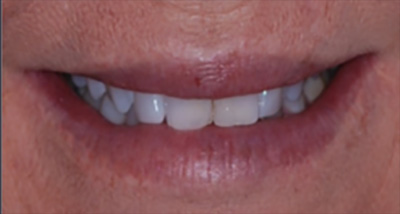
Veneers 1 – Before
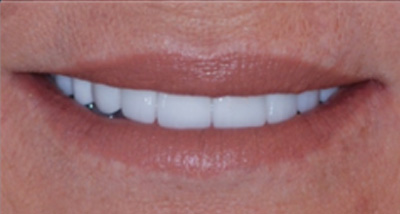
Veneers 1 – After
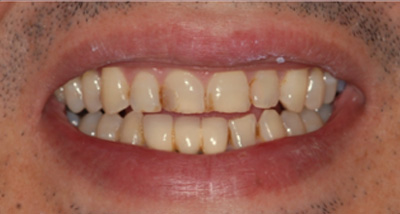
Veneers 2 – Before

Veneers 2 – After
What is Resin / Composite Bonding?
Composite bonding is the application of composite resin material to the existing tooth. Bonding is used for filling cavities, masking discolored teeth, whitening, repairing fractures, and making cosmetic improvements to the natural tooth, usually in one appointment.
How is the Composite Resin Bonding Done?
Cosmetic tooth bonding uses the composite resin to fix chipped, cracked, spaced, or uneven teeth. The resin is applied to the etched natural tooth to achieve the desired esthetic effect. Very little natural tooth reduction is necessary and usually no anesthesia is needed.
Maintaining Bonded Teeth
Bonded teeth last 5 to 8 years or longer and require professional finishing once every few years. Tips for maintaining your bonded teeth include using a nightguard, refrain from smoking, have your teeth cleaned three or four times a year, avoid chewing ice or biting fingernails, and minimize your consumption of stain-causing food and drink.
Crowns, Fillings, and Bridges
Crowns
Crown lengthening is a periodontal plastic surgery, gum reshaping procedure in which gum tissue or bone is removed to expose a greater area of the tooth structure. This can be used for cosmetic purposes such as minimizing the appearance of a “gummy smile,” or prosthetic purposes such as exposing more tooth to support a crown or filling.
How Is Crown Lengthening Done?
The gum is reduced or reshaped by moving small amounts of gum tissue in desired areas. The goal is to lengthen the appropriate teeth and create greater symmetry at the gum line.
Am I a Candidate for Crown Lengthening?
Candidates for crown lengthening are those in good general health, specifically those with healthy gums. Those with a gummy smile, decay, or a crack near the gum line are also strong candidates. If you suffer from periodontal disease or have insufficient bone you may not be eligible for this procedure.
After Surgery
Healing time varies from patient to patient depending on the amount of tissue removed during the procedure.
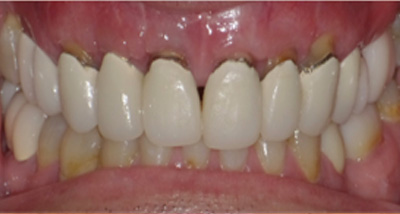
Crowns 1 – Before
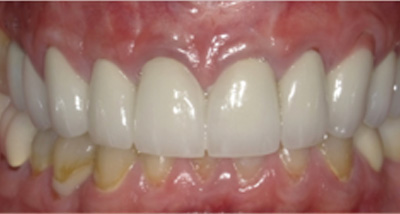
Crowns 1 – After
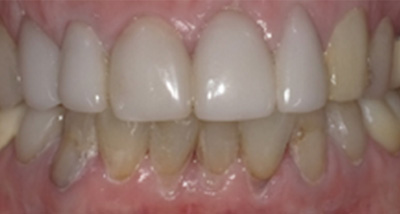
Crowns 2 – Before
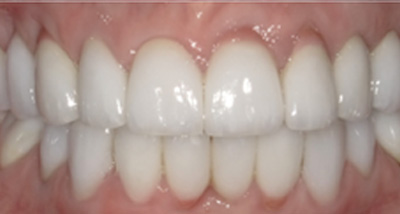
Crowns 2 – After
Tooth Restoration - Crowns, Fillings, Bridges
We will assess the best type of tooth restoration for your mouth.
Operative and Fixed
Materials used for Tooth Restoration (Fillings and Crowns)
This information will help you make decisions about selection of materials as tooth restorations in your mouth. Several types of metals are used in dentistry for the replacement of oral structures. Most of these metals are considered to be inert when placed in the body, while others have been controversial. Plastics and ceramics are used commonly as tooth restoratives, and although controversial, these have not been shown to have adverse biologic responses.
Material Choices for Fillings
Resin or Composite
Average longevity 6-15 years, tooth colored, moderate to high cost. Best used in small- to medium-sized restorations for front or back of teeth.
Ceramic
Average longevity 10-20 years, tooth colored, moderate to high initial cost. Best used in moderate- to large-size restorations for back of teeth.
Gold Inlays and Onlays
Average longevity 20 years or longer, gold colored, moderate to high initial cost. May be used in most locations where metal is not displaced to an objectionable level.
Material Choices for Crowns (Caps) or Fixed Prostheses (Bridges)
All-Ceramic
These restorations are fabricated from various ceramics. Average longevity is under study, moderate to high initial cost. All-ceramic fixed prostheses may be used in some clinical situations. These materials are being improved constantly. Their use is growing rapidly and they are expected to eventually replace metal-containing restorations.
Advantages of Ceramic Crowns and Fixed Prostheses:
- They can be constructed to a highly acceptable esthetic level. These restorations are the most beautiful and natural-appearing restorations in dentistry.
- Ceramic restorations do not have metal undercopings, as do porcelain-fused-to-metal crowns. Therefore, these crowns are biologically compatible and have extremely low allergenicity or toxicity.
Disadvantages of Ceramic Crowns and Fixed Prostheses:
- In the past, some of these restorations were not as strong as metal or porcelain-fused-to-metal restorations. If the bite was especially abusive, some ceramic restorations did not have adequate strength. However, the use of extremely strong ceramic materials, introduced in the last few years, are now becoming the most-used materials for crowns.
- Some types of ceramic restorations can be made into fixed prostheses (bridges) with adequate longevity expectations and others cannot
Porcelain-fused-to-metal
Average longevity 20 or more years, tooth colored, moderate to high initial cost. May be used in any area where extreme biting stress is not present, and patient does not have severe tooth grinding habit.
Metal Alone
High-noble, noble, or base metal. Average longevity 20 years to life, gold or "silver" color, moderate to high initial cost. May be used in any area where metal display is not objectionable.
Advantages of Gold Alloy Restorations:
- The longevity of cast gold restorations is greater than any other tooth restoration. Many patients and dentists report 40-50 years of service. Average longevity for gold restorations is at least 20 years.
- Wear of opposing teeth is minimal with cast gold restorations. Gold alloy wears almost exactly like tooth enamel. 3. Gold restorations are strong and can be made to fit teeth exactly. When cemented with decay-preventative cement, the restorations resist further decay.
Disadvantages of Gold Alloy Restorations:
- Gold restorations are not tooth-colored, and most people object to placing them in areas of the mouth that display the metal.
- The cost of cast gold restorations is higher than some other types of restorations because of the cost of the gold alloy.
Resin/Composite
These restorations may be used for single crowns. Average longevity is several years. Research on its longevity is still underway.
Advantages of Resin/Composite Restorations:
- They do not wear opposing teeth during chewing.
- Resin/composite restorations have very low allergenicity or toxicity.
- Some brands of resin/composite restorations can be constructed into fixed prostheses (bridges) when teeth are missing.
Disadvantages of Resin/Composite Restorations:
- Opposing tooth structure wears the resin/composite restorations over a period of years.
- It is more difficult to achieve optimum tooth color matching with resin/composite than with ceramic.
- Resin/composite restorations are not as strong as all-ceramic or porcelain-fused-to-metal restorations.
Teeth Whitening
In our office, we offer the following teeth whitening procedures as well as polishing and microabrasion. Ask us about which option is right for you.
GLO® Science PRO White
GLO® (Guided Light Optic) technology guarantees you the whitest, brightest smile in the dental office and at home, without the sensitivity. In office treatments are fast (32 minutes) with no more impressions or messy trays.

Before

After
Zoom! In-Office Whitening System
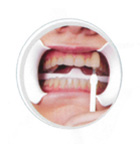
Before
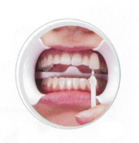
After
Zoom! Chairside Whitening is a safe, effective, and very fast tooth whitening procedure that is scientifically advanced and patent pending. The Zoom! In-Office Whitening System will make your teeth dramatically whiter in less than an hour. The procedure is simple. It begins with a short preparation to cover your lips and gums, leaving only your teeth exposed. The Zoom! clinician then applies the proprietary Zoom! Whitening Gel, which was designed to be used with a specially designed light. The Zoom! Light and gel work together to gently penetrate your teeth, breaking up stains and discoloration. With proper care your smile will sparkle for years.
Three standard methods of teeth whitening are teeth polishing, teeth bleaching, and microabrasion, all of which brighten the appearance of your smile.
Tooth Polishing
Tooth polishing is the best option for those with slight surface staining and those seeking a natural look rather than a bright white smile, and those looking for a cost-effective way to brighten their smile. The result is achieved by using a combination of a slow-speed hand piece and a special stain removing polish.
Teeth Bleaching
The bleaching process uses a strong oxidizing agent to lighten the teeth such as hydrogen peroxide or carbamide peroxide. It can be done in the dental office with a more concentrated solution with a special bleaching light or laser, or at home using a customized tray with a less concentrated bleaching gel.
Microabrasion
Microabrasion is the process of rubbing a special concentrated stain-removing compound on the teeth to remove very white or brown enamel stains over a series of appointments.
Maintaining Whitened Teeth
Ideally, you should brush your teeth after every meal with a whitening toothpaste, but at the very least, a nightly brushing with a good stain-removing toothpaste will help. Allowing food staining particles to remain on your teeth can lead to discoloration.
If your teeth tend to stain rapidly after a professional cleaning. Use a straw when drinking coffee or tea to help the liquid bypass your teeth, maintaining whiteness. Refrain from smoking, a major cause of discoloration which quickly stains your whitened teeth.
Follow a professional bleaching appointment with a home-based whitening kit. Ask your doctor about special kits offered at the office and have the procedure repeated as often as needed.
Bleaching Teeth In Office
Bleaching healthy teeth that are discolored is an effective procedure, but you should know some important information before deciding to have this procedure accomplished on your teeth:
- Bleaching is the most conservative and least expensive procedure available to whiten live, stained teeth.
- Bleaching teeth at home is an alternative to in-office bleaching, and it should be considered.
- Bleaching in the dental office requires one or more 30- to 60-minute appointments.
- Slight to moderate tooth discolorations can usually be removed successfully.
- Some teeth whiten easily, but others bleach less successfully. The only way to determine the bleaching potential of your teeth is to accomplish the bleaching procedure and evaluate the results.
- Bleaching in the dental office may be somewhat uncomfortable during bleaching and for a short time after the procedure.
- If discoloration is severe, crowns or veneers are usually more acceptable treatment to lighten tooth color.
- Your bleached teeth will require retreatment occasionally to maintain the color to which they have been bleached.
Tooth discoloration may be caused by aging, consumption of staining substances such as coffee, tea, colas, tobacco, red wine, etc., or consumption of certain antibiotics or excessive fluoride during tooth formation. Almost anyone can benefit from tooth whitening. However, treatment may not be as effective for some as it is for others. At your next appointment, ask if you are a viable candidate for this procedure. The degree of whiteness will vary from patient to patient, depending on the structure of the teeeth.
Extensive research and clinical studies indicate that whitening teeth under the supervision of a dentist is safe. However, teeth whitening products are not recommended for children under 13 years of age and pregnant or lactating women.
Bleaching Teeth Outside Office
Bleaching must be accomplished before doing any fillings, crowns, bridges, or partial dentures. Please advise us if you want to lighten your teeth. Hydrogen peroxide has been used successfully for many years to lighten the color of teeth. Originally, it was applied only by dentists. Now, patients may also apply bleaching gels to their teeth at home. Althought tooth bleaching compounds can be purchased by patients in pharmacies or grocery stores, the most effective bleaching techniques may be obtained from dentists. It is preferable for dentists or dental staff to supervise bleaching. If bleaching is not supervised, crowns and fillings present in your mouth may not match natural tooth structure after bleaching. Bleaching teeth with peroxide contained in special trays outside the dental office is the most popular method to achieve whitening of teeth.
Potential Side Effects:
Tooth Sensitivity
This condition can be minimized if bleaching times are reduced, or it is eliminated if bleaching is discontinues for a few days. Post-bleaching application of fluoride reduces sensitivity.
Gum Tenderness
Occasionally, gum tissues become irritated, and sometimes a harmless, mild sloughing of the superficial layers of the gum occurs. Reduction of bleaching time or elimination of harmless, mild bleach stops the sloughing.
Cracked Teeth
Cracked Tooth Syndrome
Often, teeth crack when subjected to the stress of chewing hard foods, ice, or hard objects, or just from normal chewing. Teeth with or without restorations (fillings) may exhibit this problem, but teeth restored with typical silver alloy or tooth-colored restorations are most susceptible. Older persons have more cracked teeth than younger people.
Symptoms and signs include the following
- Pain on chewing
- Pain on cold-air application
- Pain when eating sweets
- X-ray evidence of the problem is sometimes not present
- Usually, dental decay is not present.
- Easy verification of the crack by the dentist when the tooth is prepared for restoration
Treatment of Cracked Teeth
Simple Crack
The majority of cracked teeth (estimates are about 9 out of 10) can be treated by placement of a simple crown (cap) on the tooth. When the tooth is prepared for the crown and a temporary restoration is placed, the pain usually leaves within a few days. If this is the case with your tooth, we will place the final crown without a problem on your next appointment. The condition should then be solved.
Complex Crack
Occasionally, (about 1 in 10) the tooth cracks into the pulp (nerve) of the tooth or deeply below bone. If pain persists after placement of the temporary crown, you may have a crack into the pulp or bone support of the affected tooth. This tooth may require endodontics (root canal therapy) before the crown is placed. This procedure requires about two additional appointments before the crown is placed and is less predictable than simple cracks.
Tooth Cracked in Half
Occasionally, a tooth cracks into two separate pieces, requiring removal of the entire tooth, or removal of one of the pieces, root canal therapy, and a crown on the remaining piece.
713.622.1707 | 713.622.5046
3355 West Alabama, Suite 200
Houston, TX 77098
info@maryrileydds.com

Mary F.Riley,D.D.S.,P.C.
Aesthetic Restorative Dentistry